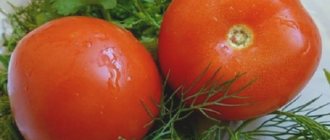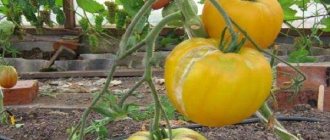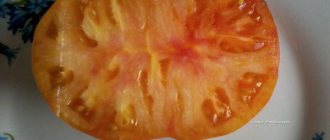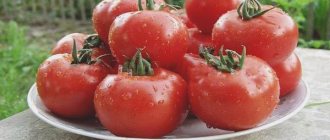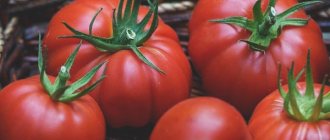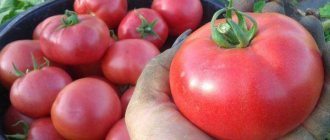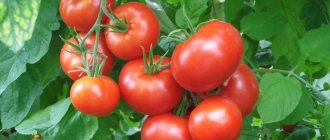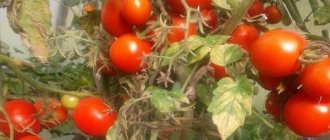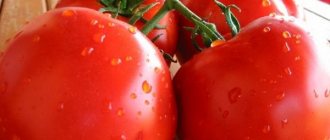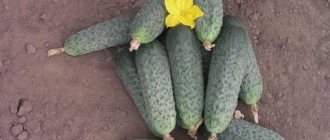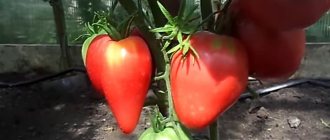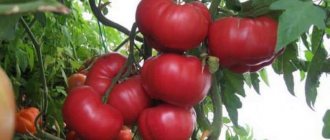The highlight of the Korolevich variety is the original form of tomatoes, adaptation to difficult northern weather conditions, and prolonged fruiting. The tomato belongs to the Altai selection and is valued for its cold resistance and endurance.
| Height | Landing location | Ripening time | Fruit color | Fruit size | Origin | Fruit shape |
| Tall | Greenhouse, Open ground | Mid-season | Pink | Large | Variety | Heart-shaped |
Tomato variety Korolevich
Altai breeders truly presented a royal gift to vegetable growers. Meet the Korolevich tomato, and this vegetable fully lives up to its name. The Central Siberian Botanical Garden of the SB RAS, Agro LLC and the peasant farm "Sergey Nikolaevich Kondakov" worked on its creation. In 2008, the variety was registered in the State Register of Breeding Achievements of Russia and received permission for cultivation in all regions of the country. Recommended for growing in open ground. In cool regions, it is better to plant tomatoes in protected soil. Our hero is not a hybrid.
Description
The plant is indeterminate, 1.5 - 1.8 meters high. The bush is spreading, the foliage is moderate, which means that more nutrients will go to the fruits. The leaves are ordinary, with a slightly wrinkled surface, medium in size, green. Inflorescence of simple type. The first fruit cluster is formed after 6 - 7 leaves. The peduncle is without articulation.
The fruits are very large and heavy, the State Register recorded a weight of 200 grams, the originator provides data on weight from 200 to 800 grams. Tomato growers confirm that the crop is indeed large-fruited, the average weight of tomatoes is about 350 grams. If the plant is formed correctly and the brush is rationed, then you can get specimens of 900 grams. Tomatoes have a not too dense structure, heart-shaped, slightly ribbed. The skin is glossy, not thick. An unripe tomato is green in color, without a dark spot at the stalk. When ripe, they become deep pink. The cut flesh is the same pink, tender (it just melts in your mouth), juicy, not watery, very meaty. Although the pulp is multi-chambered (the number of nests is more than 6), the chambers are very small, with a small number of seeds. The taste is excellent; many vegetable growers call the taste delicious.
Characteristics
- Korolevich, like most large-fruited trees, is a mid-season variety. About 115 days pass from the appearance of full shoots to the start of fruiting. The weather may make adjustments to these dates;
- The yield of marketable fruits, according to the State Register, is 2.0 kg per 1 square meter. In other sources, this figure is more encouraging - from 2 to 5 kg per plant;
- Tomato adaptability is very high. The crop is able to bear fruit even at low temperatures;
- The variety is resistant to major diseases, which is confirmed by many tomato growers. There is no confirmation or refutation of this information in the State Register;
- transportability is not very good. The tomatoes are too heavy and soft and can easily get wrinkled on the road;
- keeping quality is also insufficient. Ripe fruits should be immediately used for food or processed;
- method of use is universal. Meaty tomatoes are primarily used for making salads. The harvest can also be processed; the pulp makes excellent juice, paste, sauce, small tomatoes can be pickled and salted.
Agricultural technology
Seeds for seedlings are sown at the end of March. Plants are ready for transplanting into the ground in 60 - 65 days. The bushes are tied up and formed into 2 stems, and to get very large specimens - into 1 stem. The culture is demanding on watering and fertilizing. Preventive spraying is required.
Korolevich is a productive variety that delights with its delicious taste. Vegetable growers are generally very satisfied with the crop. Tomato requires standard agricultural technology. The only disadvantage of the variety is the presence of green shoulders, which appear in cold weather, with insufficient lighting or improper feeding. You can collect the seeds yourself.
Advantages and disadvantages
Breeders generously endowed the tomato with positive characteristics.
- The tomato adapts well to various climatic zones. In cool areas, tomatoes are grown in film-covered greenhouses.
- The variety is resistant to attacks by common crop diseases.
- The yield is high: 4-5 kg are harvested from each bush per season.
- The fruits have a marketable appearance and excellent taste.
- In the kitchen, fresh tomatoes are used, processed into juice, paste, and delicious sauces are prepared.
The disadvantages include:
- The tomato does not last long. The harvested crop should be processed in the coming days.
- Heavy and soft tomatoes cannot be transported.
Advice. If you need to transport a small amount of fleshy and large fruits, it is better to wrap each one in paper and place it in a box in one layer.
Tomato Korolevich: description and characteristics of the variety, gardeners’ opinion with photos
Some varieties of tomatoes are valued for their fertility and high yields, others for their unpretentiousness and excellent immunity. The Korolevich tomato attracts with its original shape of the fruit, seduces with its excellent taste and captivates with its versatility of use.
Characteristics of tomato
The Korolevich tomato is a varietal variety bred by Altai breeders and adapted to the difficult Siberian growing conditions. Mid-season variety of indeterminate type. It begins to bear fruit 115–120 days after germination.
Description of the variety:
- the bush is sloping in shape and can reach a height of 1.5 to 1.8 m;
- leaves are small, dark green;
- inflorescences simple, stalk without articulation;
- the yield is average - an average of 2 kg of tomatoes per bush;
- the plant has increased resistance to most diseases of nightshade crops.
Having studied the reviews about the tomato, you can notice an interesting trend: almost all commentators, among the positive characteristics, note the amazing resistance of the tomato to temperature changes. And for good reason, because Korolevich does not stop bearing fruit even at low temperatures.
Description of fruits:
- heart-shaped, slightly ribbed;
- the fruits are large, weighing from 200 to 800 grams;
- ripe tomatoes acquire a delicate pink color;
- the pulp is loose, juicy;
- inside the fruit is divided into 6 segments;
- rich taste and aroma.
The Korolevich tomato variety is widely used in cooking. Due to its excellent taste, the tomato is suitable for both fresh consumption and heat treatment. Smaller fruits are excellent for pickling and pickling, while larger ones are suitable for sauces, marinades, juice and other preparations.
Recommendations for cultivation and care
Korolevich is recommended for growing in closed and open ground using the seedling method:
- Sowing should be done in March, on previously prepared and slightly compacted soil, mulched with a topsoil layer or peat. The mulch layer should not exceed 1 cm.
- Next, the seedlings need to be poured with warm water through a sieve so as not to wash out the thin top layer. Cover the container with film and place in a warm place. Recommended temperature for germination is +25 degrees.
See also Growing tomato Grigorashik f1 and description of the variety Read
- When the seedlings hatch, the film should be removed and the seedlings should be moved to a bright place. And during the first week, maintain the temperature within +14–16 degrees, then increase to +20–22 degrees.
- The appearance of the first true leaves means that it is time to plant the sprouts in separate containers.
- At the age of 60–65 days, when the sprouts already have 6–7 leaves and the first flower cluster has formed, the seedlings should be transplanted to a permanent habitat.
- It is recommended to plant the bushes at a distance of half a meter from each other, and place organic fertilizers in the holes before planting.
- During the growth process, a tomato requires the formation of one or two stems and tying to a support, since the plant tends to bend under the weight of the fruit.
- Despite the name, Korolevich is not too demanding of care and attention. It is enough to provide the tomatoes with regular watering and periodic fertilizing, as well as from time to time to loosen the soil between the bushes and hill them up.
The fruits ripen gradually, allowing you to enjoy them until September.
Reviews
“Tomato variety Korolevich is the tomato prince. I really love this variety. Tomatoes are beautiful and incredibly tasty. And the yield is much higher than stated in the description.”
“Korolevich is indeed an interesting variety. The fruits are all the same shape, but different sizes, from babies to giants. Very comfortably. You can add it to the salad and add salt for the winter.”
Care
The Korolevich tomato variety does not require painstaking care. It is enough to ensure that the soil is not overdried or waterlogged, regularly apply fertilizers and loosen the soil.
When the first ovaries appear, it is necessary to remove the lower leaves from the bushes and tear off third-party shoots so that they do not take nutrients from the fruit.
Do not water tomatoes abundantly, especially by splashing moisture on the leaves. It is better to moisten the soil by adding water in small portions to the stem. It is important to tie the tomatoes to the support in a timely manner.
Organic feeding - bird droppings, compost, manure, peat - is applied every 14-15 days. You can also add lime and superphosphate.
Tomato Korolevich description and characteristics of the variety, gardeners' opinion with photos
Description of the heart-shaped tomato Korolevich and cultivation features
Tomato Korolevich is a mid-season indeterminate variety. It has fleshy pink fruits that are ideal for salads.
The characteristics and description of the variety are as follows:
- The fruits are quite large, the weight of a ripe tomato reaches from 200 to 800 g.
- The Korolevich tomato is heart-shaped.
- The fruits can be used both fresh and canned.
- Seeds should be sown at the end of March.
- Before you start sowing, you should prepare the container, soil, room and lighting.
- The container for sowing must be made of plastic and must have drainage holes.
- If the water stagnates in it, the plant may develop blackleg disease.
- It is advisable to disinfect containers and soil before sowing. This can be done using a solution of potassium permanganate, or you can lower the bag of soil into hot water and let it sit in it until the water cools completely.
A little history
The tomato is the fruit of a perennial nightshade plant called tomato.
This word and the plant itself came to Russia from France, and to France from Italy, presumably in the 16th century. In Italy, the plants were called pomo d'oro - “golden apple” and they were yellow-sunny in color, because this is how the Mays and Aztecs grew them, believing that “tomatli” were sent to them by the solar goddess of medicine, health and healing - Ishtilton (Ichtilton) .
The Spaniards, who introduced Europe to this golden berry after 1520, introduced it as “pommel de Peru” - “apple from Peru.” The loving French gave the “apple” its name, which the Russians also used for a long time - “une pomme d 'amour' - 'love apple'.
Both the French and the Spaniards used tomatoes as a remedy for coughs and as a powerful remedy for increasing potency, but frequent consumption of la mela d'oro (“golden apple” - Italian), according to scientists of that time, threatened death.
Such a gift for anyone's heart!
In 1780, new fruits from Italy were served at the table of Catherine the Second, most of which were “golden apples”. The empress liked the new fruit so much that by the greatest decree it was ordered to plant this vegetable for the imperial table and the process of Russification of the Italian “love” berry took on unprecedented proportions.
Oh, the queen didn’t know that tomatoes had long been settled on the outskirts of the Russian Empire as a medicinal vegetable, and Crimeans, Astrakhan, Georgians and other southerners had long mastered the methods of growing French-Italian berries!
So who is Senor Tomato? By definition, it is a fruit. In the everyday consciousness - a vegetable. According to biological classification - berry. And this fruit and vegetable has long become the king of our greenhouses and gardens!
What varieties of tomatoes does the 21st century offer us?
Characteristics of Korolevich variety tomatoes
Tomato Korolevich is one of the most popular varietal varieties of tomatoes among vegetable growers. The variety is characterized by its versatility of use, as it has excellent taste, which allows it to be consumed both fresh and canned.
Characteristics of Korolevich variety tomatoes
Characteristic
Many gardeners are familiar with this variety of tomato. Its varietal characteristics are the result of the painstaking work of specialists in the field of breeding.
Tomato Korolevich
Characteristics of the variety
| Variety type | Variety |
| Bush type | Indeterminate |
| Soil type | Open ground |
| Precocity | Mid-season |
| Color | Pink |
| Fruit weight | 200 g |
| Productivity | 2 kg/sq.m |
| Taste qualities | Great |
| Application | Salads |
| Number of nests | 6 |
Tomato Korolevich is a variety developed by Altai breeders relatively recently (in 2008), but has already earned the love and respect of vegetable growers in all regions of Russia due to its amazing resistance to temperature changes, good yield and excellent taste.
Description of the variety
The Korolevich tomato variety is not a hybrid. The variety is classified as a mid-season indeterminate variety - the height of the bush in greenhouse conditions can exceed 2 m, the shape is spreading.
From the emergence of seedlings to the formation of the first fruits, 115-120 days pass. The fruits are very large, average weight 350 g. The recorded record is 800 g. The tomatoes are heart-shaped, the flesh is loose. The skin is thin. A ripe tomato has a rich pink color.
Heavy soft fruits are stored for a relatively short time and do not tolerate transportation well.
The taste of tomatoes is mild, moderately sweet. Many gourmets call it a delicacy.
In cooking, the fruits are used for preparing salads and baking. It is recommended to process most of the harvest: prepare tomato juice or paste; small tomatoes can be pickled and salted.
The yield is 2-5 kg per 1 sq. m. greenhouse: a lot depends on the conditions provided to the plant and proper care. The Korolevich tomato is resistant to most diseases typical of nightshade crops. It has excellent adaptability and can bear fruit at low temperatures.
Landing
It is recommended to sow Korolevich tomato seeds in late March-early April, following the usual algorithm for planting nightshade seedlings:
- Prepare a place in the house with sufficient lighting or purchase a special lamp. There should be no drafts in the room for tomatoes; the optimal temperature for germination is +25 degrees. The container for sowing (necessarily made of plastic) must have drainage holes;
- Disinfect the container, fill it with soil, lightly compact it;
- Sprinkle the ground with a thin layer of peat (1 cm);
- Carefully pour the soil with water through a sieve (so as not to wash away the top layer);
- Plant the seeds to a depth of 5-8 mm, sprinkle with damp soil;
- Cover the container with film and place in a warm, bright place. The “greenhouse” must be ventilated twice a day for 15 minutes.
Important! If soil for tomatoes was brought from a garden plot, it should be disinfected by watering it with a weak solution of potassium permanganate.
Growing seedlings
As soon as the first shoots of Korolevich tomatoes emerge (within two weeks from the moment of planting), the film should be removed.
In the open ground
holes in open ground should be deep enough and have a diameter of 25-30 cm
in the greenhouse
caring for plants in greenhouses is much easier. The watering regime here does not depend on the climate; it is only necessary to maintain constant humidity in the holes. the rules and features of watering tomatoes in greenhouses are described in this article. There are certain ways to garter tomatoes in greenhouses.
there is no need to bury the seedlings deeply, and it is better to tie them not to supports, but to wires stretched under the roof of the greenhouse (pull the wire tightly right over the row of tomatoes, and lower the fabric garters from it and tie them around the tops of the bushes).
Bushes that do not stretch uncontrollably upward, but are capable of timely self-restraint, are very convenient to grow. At the same time, its respectable height determines excellent productivity indicators. Its versatility is also attractive: it can be planted anywhere. True, in open ground you will need supports, but not very high ones.
Semi-determinate varieties, as a rule, are not too late, usually mid-early or mid-ripening. But you still need to step them up. In the open air, some varieties may require topping towards the end of the season (on average - early August). The standard height is from one to 1.5 (and a little higher) meters (this is observed in a greenhouse).
Tomato Eagle beak
Large, fast, productive
A wonderful variety in all respects. Created by the work of a team of famous Siberian breeders (V.N. Dederko, T.N. Postnikova, A.A. Yabrov). The variety has a state patent and has been listed in the register since 2005. Medium early in terms of ripening. The plant develops at a rapid pace: seedlings produce real leaves early and quickly grow ovaries.
Tomato Southern tan
The sweetest
The patented original variety of Dederko and Postnikova has been registered in the state register since 2007. Similar to the Golden Koenigsberg (of the same authors), which does not have a patent and is not included in the register. The powerful bush of the plant requires obligatory pinching. The harvest is high, 7.7 kg per bush was collected. Tomatoes are oval with a spout, smooth, weighing 150-170 g;
Sugary raspberry
Mid-season tomato with high adaptive abilities. Tolerant to diseases and temperature changes. But with sharp fluctuations in humidity and excess dampness in the soil, it can burst. However, on the other hand, regular watering is necessary. Responsive to any feeding. The fruits are an appetizing dark crimson color.
The watermelon pulp is sugary. The weight of tomatoes is from 290 to 560 grams and even more. The variety of these vegetables was included in the register in 2007. The bush is about 1.5 meters high, the leaves are large, dark green. The inflorescence is simple. It requires tying the plant to a support and pinching. The best results were obtained when forming a bush with 2 stems. The second trunk is the stepson, located below the first flower cluster. The remaining side shoots must be removed
Tomato Honey saved
Unpretentious and sweet
A flexible Siberian variety, easily adaptable to temperature changes: from high to low and vice versa. Tested and reliable. Ripening period is average, purpose: processing is encouraged, it better accentuates the taste in salads. In closed ground it can produce up to 5 kg. from one bush. Tomatoes are classic heart-shaped, smooth, beautiful.
When fully ripe they turn a deep orange color. Most of the crop ripens well on the vine, the rest of the fruits ripen well. They are characterized by excellent transportability and shelf-life. The weight of the fruit in the lower clusters reaches 420-530 g, closer to the top - 150-200 g. The pulp is tasty, sweet, and medicinal. Registered in the state register since 2005.
Tomato Pink Elephant
Sugary pink
In terms of ripening time, this popular variety is classified as mid-early. Included in the state register in 1998. Recommended for growing under film covers in all regions of the Russian Federation. The variety is not intended for industrial cultivation, but is appreciated by owners of small garden plots. The foliage is almost similar to potato tops.
Tomato Persimmon
Carotene piggy bank
In 1999, a variety created at the Moscow Timiryazev Academy based on varieties of folk selection type was entered into the state register. An interesting hybrid that combines many qualities: external beauty, taste and productivity. Medium-early in terms of timing (110-115 days), with prolonged fruiting.
The bushes are not too spreading, with dense large foliage. The first inflorescence emerges above the 7th leaf. There are from 3 to 4 tomatoes in a bunch - round, slightly ribbed, deep orange, weighing 230-360 g. The pulp is juicy. The taste has an aromatic sourness. The main value of the variety is the highest content of carotenoid vitamins. Vegetable yields are moderate.
Tomato Bull's forehead
Large and unpretentious
The variety adapts perfectly to greenhouse heat and street cold. Brings a decent harvest even when the year is unfavorable for growing - up to two buckets from 1 square. Tomatoes are round, slightly flattened, ribbed. Weight 0.5 kg or more. The pulp is dense. The ripening period is average; In open ground, about half of the fruits ripen.
Folk selection
Registered in the state register in 2001. An old variety of folk selection, packaged by different companies. Mid-season salad tomato. Tomatoes are round, flattened, moderately ribbed, sunny orange in color. They are meaty and sweet. There are 2-3 fruits in 1 kg. Record weight 700 g.
It has a rare quality for a meaty variety - it is resistant to cracking. From 1 square meter you can collect up to 1.5 buckets of fruit. Orange tomatoes contain much more beta-carotene than other groups of varieties of different colors. Therefore, these tomatoes are extremely popular among gardeners. The Orange Giant tomato is famous for its high yield and excellent taste.
Tomato Bugai red
Heavyweight
The newest variety (in the register since 2014) with self-limiting growth to 1.5 m. Ripening period - mid-early, with a long fruiting period. Large, flat, round tomatoes with an intense pink color ripen on the bush. The weight of the fruit reaches 600 g. Tomatoes have dense pulp, sugary at the break; the chambers contain a small amount of seeds.
Tomato Nonna M
Cordate
The newest mid-early variation of the Bull's Heart in the Siberian format. The raspberry-pink fruits are at once large, elegantly beautiful, and have a sugary taste and twist. Medium-early, from germination to the beginning of ripening 110-115 days. The plant is strong, 1.2-1.8 m high, depending on growing conditions. The fruits are elongated, heart-shaped, raspberry-pink, with a moiré tint, weighing 400-700 g.
Tomato Superbomb
The promise of record harvests
The mid-season new product promises a decent yield in open ground. The innovative Superbomb tomato is successfully grown in various regions of the country. It is not afraid of intense heat, scorching sun, and dry air. Fruit set remains consistently at a high level. The Superbomb tomato needs increased nutrition and moderate pruning. There are 5-6 tomatoes in a bunch, weighing 300-600 g. They are fleshy, rounded and flattened. The plant is compact, with self-limiting growth.
READ MORE: Timing for harvesting onions in the Urals, time to dig
Tomato Puzata Khata
Unique shape
An original new variety from agro, on the state register since 2013. For lovers of unusual tomatoes. The variety is early (105 days is not uncommon), with extended yield and a total yield of 9.6 kg per 1 square. Tomatoes have an interesting pear shape with pronounced ribs. Fruit weight 185-270 g. Purpose: salad.
The Puzata Khata tomato variety is easy to care for; large, sugary fruits have excellent taste and good keeping quality.
No acid
The variety was registered in the state register in 2015 under the name Frog Princess. The bushes are powerful, the leaves are medium sized. The ripening period is mid-early or mid-ripening (112-123 days). Fruit weight 235-280 g. They are flat-round, slightly ribbed, light green with the lower part turning yellow when ripe.
When fully ripe, the vegetables are golden-greenish, with a slight bronze tint. The pulp is juicy, dietary taste with low acidity. The yield from 1 plant in open ground reaches 5.6 kg per square; in a greenhouse - a maximum of one and a half times higher. The purpose is salad. The green color of ripe tomatoes is due to the fact that tomatoes have a high chlorophyll content.
Tomato variety Korolevich
The Korolevich tomato was created as a result of many years of efforts by Altai breeders. They managed to adapt the characteristics of this variety to the harsh Siberian climate. The fruits have a unique shape (they look a little like strawberries), the taste is pleasant, and the yield indicators are high.
Tomato variety Korolevich
Characteristics of the variety
The tomato variety Korolevich is mid-season. The fruits appear within 120 days after germination.
The plant is a first generation hybrid and its seeds cannot be used for subsequent crops, because the new generation will not meet all the varietal characteristics of the parent.
When using seeds of hybrid plants in the second generation, the characteristics are split into “maternal” and “paternal”. It is unknown how the plants will turn out in the second generation.
The variety is resistant to major diseases. Harvest from one bush up to 2 kg.
Description of the plant
The height of the bush is about 1.8 m. The leaves are bright green. The inflorescence is simple. The bush has a spreading shape, so a garter is necessary. Tolerates temperature changes well.
The shape of the Korolevich tomato is quite bizarre - it resembles a heart or a strawberry. The fruit is quite large, reaching a weight of about 0.7 kg. It is pink in color. The pulp is loose but juicy and has a bright aroma. The interior is divided into 6 parts.
The taste is pleasant. The fruits have high commercial characteristics.
One of the advantages of indeterminate varieties is the long fruiting period, especially if the plants are grown in a greenhouse. Fruit harvesting can last up to 3 - 4 months.
Application
Korolevich has found wide application in cooking. It is used both fresh and cooked. Small-sized tomatoes are used for preservation. The juice obtained from large fruits that have reached maturity is thick and rich.
Features of cultivation
Korolevich is grown using seedlings. It can be planted both in open and protected ground.
The culture is not picky about care. Particular attention should be paid to watering. It is equally important to carry out the garter on time, because Growing fruits are very heavy and can break off shoots.
Under any conditions, the yield remains unchanged. The fruits ripen gradually, which extends the period of their use.
Planting seedlings
Seedlings need a lot of light
The seeds are first disinfected in a weak solution of potassium permanganate. To improve germination, they are placed in a solution of Epin Extra for 6 hours (1 drop per 100 ml of water).
Sowing of seeds is carried out in mid-March.
- The earth mixture is lightly compacted and mulched with peat (1 cm layer).
- Seeds are sown (deepened) using tweezers.
- Then be sure to water it with warm water.
- After this, the seeded material is covered with film and placed for germination at a temperature of 25˚C.
- After the first shoots appear, the film is removed and the seedlings are transferred to a lighted place.
- During the first 7 days, the daytime temperature is 18-20˚C, the night temperature is 16 degrees, and only then it is raised to 22˚-24C.
During the entire period of seedling growth, monitor the humidity in the room.
After the appearance of 2 true leaves, pick them using larger cups. This makes it possible to develop a more powerful root system.
Fertilizer
Fertilize regularly, and do not forget to remove weak shoots.
The process of fertilizing seedlings has its own nuances: it is watered in the evening, and a solution of preparations is added in the morning.
- The first feeding is root feeding. When the first true leaves appear, use any complex fertilizer with a high nitrogen content (0.4 g superphosphate, 0.5 g urea, 1.5 g potassium salt per 1 liter of water);
- The second - a week before the dive: 4 g of superphosphate, 0.6 g of ammonium nitrate and 2 g of potassium;
- The third - a week after. Use any Kemira complex fertilizer for tomatoes (description of use in the instructions).
Transplanting seedlings
After planting, the plants must be watered well.
After 1.5-2 months, the plant has 6 or 7 leaves and flower clusters begin to form. This indicates that it is time to transplant the seedlings into the ground:
- Having chosen a day suitable for the weather, before planting, pre-form holes;
- the distance between them is up to 0.5 m;
- add 1 tbsp to each. organics;
- seedlings are planted in these seats one at a time;
- Afterwards, water abundantly and loosen the top layer of soil to avoid the appearance of a crust on the surface of the soil.
As the plant forms, it is tied to a specially prepared support, because the stem may break under the weight of future fruits.
According to the characteristics of the variety, Korolevich tomatoes need to be regularly watered, fed, and the soil around the bushes must be loosened and hilled.
Do not forget that the crop loves fertilizing with nitrogen, phosphorus and potassium fertilizers, such as Universal. Use organic matter in the form of herbal or ash tinctures for feeding. By using everything together, you can achieve a high yield.
Water for irrigation should be settled and heated by the rays of the sun. Pour at the root of the plant, without getting on the leaves.
Cold water can destroy a tomato while it is still growing.
Before the procedure, lightly loosen the soil and do not forget to check it. If the ground is still wet, postpone the activity to another time.
Disease Prevention
According to the description, the Korolevich variety has good resistance to various diseases, but if basic care rules are not followed, the tomato can become infected with late blight.
Excessive watering causes root rot. This can be determined by external signs - yellow leaves appear on the plants, growth and formation of fruits stops.
For prevention, the resulting stepsons are removed. This gives the bush ventilation and prevents late blight. After harvesting, fruit-bearing plants are removed.
Reviews
Korolevich is easy to grow and care for. The characteristics of the variety allow it to be grown even by novice gardeners. The tomato easily achieves good yield. The fruits ripen in stages, which allows you to prepare them in time and enjoy them until the beginning of October.
Pest control is simple. It is enough to carry out preventive actions in time and before planting it is better to pour wood ash into the holes.
Some gardeners insist on traditional fertilizers, because... they are time-tested and not so toxic.
